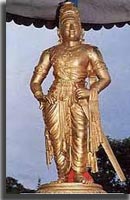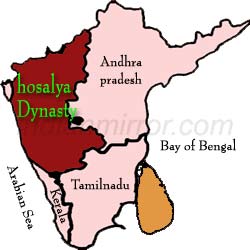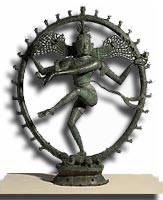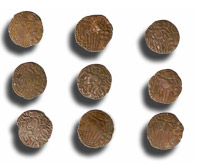History :
Cholas rule forms an important part in the history of South India. It saw remarkable progress in almost all spheres of life such as polity, culture and economy. In 9th century, the Cholas gained control and overthrew the Pallavas. They ruled in the south of India from the 9th to 13th Century. The Indian Chola Empire conquered not only south of India but also extended their empire over the seas and ruled parts of the Maldives and Sri Lanka.
Vijayalaya
The founder of Chola Kingdom was Vijayalaya who conquered the kingdom of Tanjore during mid 8th century. The Indian Chola dynasty is an important landmark in the history of India. The Chola Empire occupied present Tanjore and Trichirappalli districts with some adjoining areas. The rule of Chola dynasty rose to prominence in 850 when their ruler Vijayalaya defeated the Pallavas and took over Tanjore from them. Due to the conflict between Pallavas and Pandyas, Vijayalaya occupied Tanjore and made his capital. He was succeeded by his son Aditya-I.
Aditya-I
Aditya-I defeated Pallava king Aparajita and also Parantaka Viranarayana, the Kongu ruler. After Aditya-I the kingdom was ascended by his son Parantaka-I who ruled between 907 to 955 AD. Cholas power earned supremacy under his reign. Parantaka-1 annexed territory of Pandya King and soon conquered the Vadumbas. He defeated away all of the Pallavas power.
Rajaraja Chola

He defeated the eastern Chalukyas of Vegi, the Pandyas of Madurai and the Gangas of Mysore. He was an able administrator and also a great builder. Rajaraja chola built a magnificent temple at Tanjore, which is named as Rajarajeshwar after his name.
Rajendra Chola
Rajendra I (1012 1044 AD) was also an able ruler like his father Rajaraja Chola. He went upto Bengal and became victorious on the banks of Ganges. He was given the title of "Gangaikonda" (the victor of Ganges). He built up a new capital called Gangaikondacholapuram. Rajendra Chola's greatest achievements was the conquest of Andaman and Nicobar islands. During Rajendra Chola reign the kingdom was called the "Golden Age of Cholas." After his death the Chola kingdom began to decline. His successors were weak and so the kingdom started disintegrating.
Vira Rajendra
Vira Rajendra (1064 - 1070 AD) the elder brother of Rajendra-II succeeded his brother to reign for the next seven years. He conquered the invasion of Chalukya King and defeated the Chalukya ruler.Vira reconquered Vengi and foiled the efforts of Vijayabahu of Ceylon who was trying to drive the Cholas out of Ceylon. While Someswara-II succeeded the Chalukyas throne, Rajendra made some incursions but later on built friendly ties by giving his daughter to Vikramaditya. Soon after the death of Vira Rajendra in 1070 AD, there was a contest for the throne and Adhi-Rajendra, the heir apparent took the throne.

Place |
Patna, Bihar, Bengal & Srilanka |
Period |
Patna, Bihar, Bengal & Srilanka |
Language |
Tamil |
Religion |
Hinduism |
Kings |
Vijayalaya, Aditya-I, Rajraja Chola, Rajendra Chola, Vira Rajendra, Kulottunga - I, Vikrama Chola
|
Kulottunga - I
Rajendra-II succeeded Adhirajendra who got the title as Kulottunga Chola. In about 1073, Kalachuri King Yasahkarana invaded Vengi but did not gain anything. Pandyas and Chera's attack were defeated down by Kulottunga. The southern Kalinga revolt was also put down. In about 1118 AD, the Viceroy of Vengi - the Vikramaditya VI took control of Vengi from Chola and thus succeeded in separating the Cholas from the Eastern Chalukyas. Gangavadi and Nolambavadi were lost to Hoysala's Vishnuvardhana.
Vikrama Chola (1120 - 1135 AD)
The next successor, the son of Kulottunga-I restored the Chola power by reconquering Vengi and by taking control of part of Gangavadi. His reign was somewhat peaceful to his subjects though there were floods and famines in South Arcot. The Hoysala expansion took control of Chola power slowly and subsequently. The last rulers namely Kulottunga - II, Rajaraja - II, Rajadhiraja - III could not stop the Hoysalas annexation of Chola Kingdom. Cholas hold on Pandyan kingdom had already weakened. In about 1243, the Pallava chief declared independence. The Kakatiyas and Hoysalas partitioned among themselves the territory of the Chola Empire and Chola Empire ceased to exist for ever.
Administration and Art

Culture and Society



